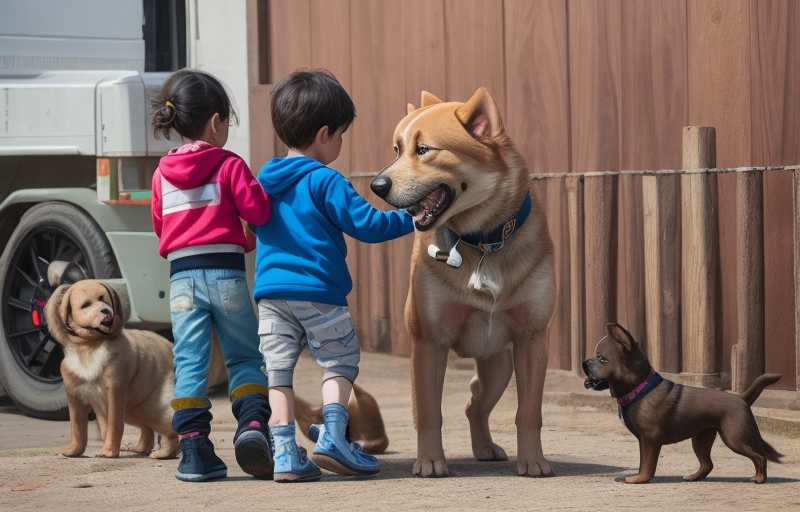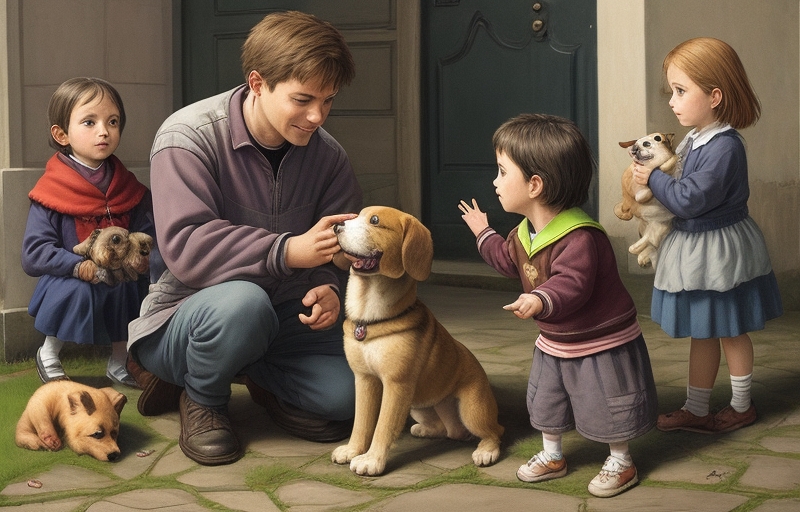Explore the dynamics between dogs and children, learning how to build a strong and positive bond while prioritizing safety. Discover essential tips on choosing the right dog, early socialization, supervision, and basic obedience training to create a harmonious environment for both.
Introduction:
Dogs have long been cherished members of families, offering companionship, loyalty, and love. When children are added to the mix, it becomes essential to understand and navigate the dynamics between dogs and kids. Fostering a strong bond between them requires a combination of education, supervision, and training. This article delves into the intricacies of the relationship between dogs and children, guiding building a positive connection while prioritizing safety to prevent accidents.
Read Also: Teaching Your Dog to Whisper: 10 Steps Guide
Understanding the Dynamics:
The bond between dogs and children is often magical, providing both with a playmate and confidant. However, recognizing the unique communication styles of each is crucial. Dogs communicate through body language, and children, especially younger ones, may not comprehend these signals. Teaching children to respect a dog’s space and understand their cues is fundamental.
Building a Strong Bond and Ensuring Safety
Choosing the Right Dog:

Certain dog breeds are known for their gentle and patient nature, making them excellent companions for families with children. When considering adding a dog to the family, research breeds that are known for their compatibility with children. However, it’s essential to remember that individual personalities vary, so evaluating the specific temperament of a dog is equally important.
Early Socialization:
Early exposure and positive socialization experiences are vital for both dogs and children. Introducing a dog to various environments, people, and situations during their early months helps them develop into well-adjusted adults. Similarly, exposing children to appropriate canine behavior instills a lifelong understanding of how to interact with dogs respectfully.
Supervision is Key:
Regardless of how well-behaved a dog may be, constant supervision is non-negotiable when dogs and children are together. Accidents can happen in an instant, and even the most well-trained dogs may react unexpectedly to a child’s behavior. Always be present when they interact, teaching both the child and the dog appropriate ways to engage with each other.
Teaching Boundaries:

Both dogs and children need to understand and respect each other’s boundaries. Teach children not to disturb a dog while eating or sleeping and to avoid taking their toys or food. Similarly, ensure that the dog has a safe space where they can retreat when they need a break from interaction.
Regular Exercise and Playtime:
Ensuring dogs receive adequate exercise and playtime is fundamental to building a strong bond with children. Dogs, especially those with high energy levels, benefit from regular physical activity. Engaging in interactive play sessions not only keeps the dog physically fit but also provides an opportunity for children to actively participate in the care and well-being of their furry friend.
Encouraging Gentle Touch and Respect:
Teaching children the importance of gentle touch and respect for a dog’s body language is a crucial aspect of ensuring safety. Emphasize the significance of avoiding sudden movements, loud noises, or any behavior that may startle or distress the dog. Encourage children to approach the dog calmly and to pet them gently, promoting a positive association with physical contact.
Establishing Routine and Predictability:
Dogs thrive on routine and predictability, and incorporating these elements into their daily lives can significantly contribute to a strong bond with children. Establish consistent feeding times, walks, and play sessions, creating a sense of security for the dog. In turn, this routine helps children understand the dog’s needs and reinforces the concept of responsibility.
Basic Obedience Training:

Basic obedience training is beneficial for any dog, but it becomes especially crucial in a household with children. Commands such as sit, stay, and leave it can help manage the dog’s behavior and create a safer environment. Involving children in training sessions can also strengthen their bond with the dog.
Safety Measures:
Implementing safety measures is paramount in preventing accidents. Teach children not to approach strange dogs without permission and supervision. Additionally, instruct them on how to properly pet a dog, avoiding sensitive areas such as the ears and tail. Regular veterinary check-ups and keeping the dog’s vaccinations up-to-date contribute to overall safety.
Conclusion
By understanding the unique communication styles of both dogs and children, choosing the right dog breed, emphasizing early socialization, and implementing safety measures, families can create an environment where their furry and human members thrive together.
FAQs:
Can any dog breed be suitable for families with children?
While individual personalities vary, certain breeds, such as Labrador Retrievers, Golden Retrievers, and Beagles, are known for their gentle nature and are often good choices for families with children.
At what age can a child be taught to interact safely with a dog?
Children can start learning to interact safely with dogs from a very young age. However, constant supervision is crucial until the child demonstrates a clear understanding of appropriate behavior around the dog.
How can I help my child overcome a fear of dogs?
Gradual exposure, positive reinforcement, and allowing the child to observe calm and well-behaved dogs from a distance can help alleviate a fear of dogs. Professional guidance may also be sought if needed.
What should I do if my dog shows signs of discomfort around my child?
If a dog exhibits signs of discomfort, such as growling, lip licking, or avoiding the child, intervene immediately. Consult with a professional dog trainer or behaviorist.

1 thought on “Dogs and Children: Building a Strong Bond and Ensuring Safety”